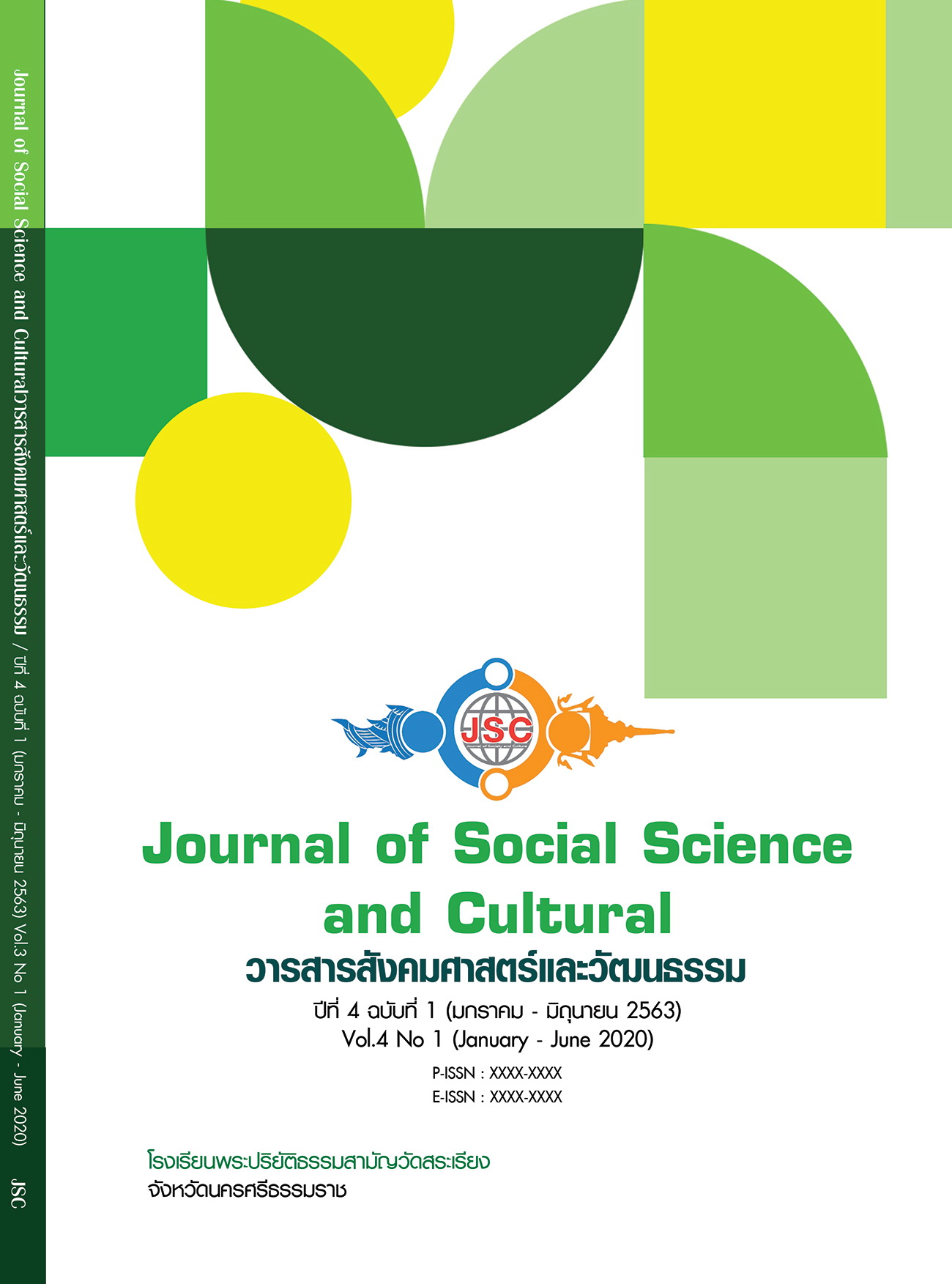PUENG YUAN: HOW TO INHERENTLY CATCH PUENG YUAN TO PROMOTE CAREERS IN THE COMMUNITY: A CASE STUDY BAN TORNWANGPRANG VILLAGE NO.9 LA - AI SUB - DISTRICT CHAWANG DISTRICT NAKHON SI THAMMARAT PROVINCE THAILAND
Main Article Content
Abstract
The objectives of this research article were to: 1) study the method for catching Pueng Yuan inherently, 2) study the problem of catching Pueng Yuan inherently, and 3) study guidelines for promoting catching Pueng Yuan inherently. This research was qualitative research method by document study and specific sampling interview. The entire sample group was bee keepers who catch Pueng Yuan inherently and supporters. The sample group was divided into 2 groups 1) bee keepers who catch Pueng Yuan inherently, and 2) supporters, both groups are 15 persons who familiar with catching Pueng Yuan inherently and have been catching Pueng Yuan inherently for more than 5 years. The data was analyzed and concluded to cast an overview. The research found that: 1) The method for catching Pueng Yuan inherently are consisted with 9 steps: 1.1) Wai Khru ceremony, 1.2) selecting the tree to catch Pueng Yuan, 1.3) preparing equipment, 1.4) casting spells to the bees, 1.5) driving stakes into the tree for climbing to catch bees, 1.6) tying Kru rope, 1.7) banishing bees with smoke, 1.8) cutting the honeycomb into a container, and 1.9) packaging of honey bottle. 2) There are 7 problems of catching Pueng Yuan inherently: unclean packaging, storing honey the wrong way, weather conditions, inheritor, using inappropriate materials to catch bee, accident due to catching bees and the bee’s pest problem. 3) The 7 guidelines for promoting catching Pueng Yuan inherently for promoting careers are packaging designs, knowledge of honey storage, wisdom for catching Pueng Yuan inherently support, inherit the knowledge to new generation, production process and raw material selection in the community, enhance knowledge about how to prevent danger from catching bees and 3.7) bee’s pest elimination.
Article Details
References
ชอง เมืองขวา. (2554). ภูมิปัญญาการตีผึ้งยวน. (พิมพ์ครั้งที่ 3). กรุงเทพมหานคร: จุฬาลงกรณ์มหาวิทยาลัย.
ทิพย์ทิวา สัมพันธมิตร. (2556). การอนุรักษ์ภูมิปัญญาการจับผึ้งหลวงเพื่อการใช้ประโยชน์อย่างยั่งยืน: กรณีศึกษา ชุมชนบ้านถ้ำพระพุทธรอยต่อระหว่างจังหวัดตรังและจังหวัดนครศรีธรรมราช. วารสารมหาวิทยาลัยทักษิณ, 16(2), 55-66.
บุญชม ศรีสะอาด. (2556). วิธีการทางสถิติสำหรับการวิจัย . กรุงเทพมหานคร: สุวีริยาการพิมพ์.
มนัญญา เพียรเจริญ และคณะ. (2554). หมู่บ้านผึ้ง อ.สวนผึ้ง จ.ราชบุรี. ใน ทุนสนับสนุนโครงการวิจัย กระทรวงวิทยาศาสตร์และเทคโนโลยี ปีงบประมาณ 2554. มหาวิทยาลัยเทคโนโลยพระจอมเกล้าธนบุรี.
เมธิรา ไกรนที. (2562). การศึกษาองค์ความรู้ต้านภูมิปัญญาท้องถิ่นการจับผึ้งในพื้นที่ป่าอําเภอพรหมคีรี จังหวัดนครศรีธรรมราช. วารสารปาริชาต มหาวิทยาลัยทักษิณ, 32(1), 291-321.
Adsakul, S. (2012). Introduction to sociology. Bangkok: V.Print (1991).
Cronbach, L. J. (1990). Essentials of psychological testing (5th ed.). New York: Harper Collins Publishers.
Santasombat, Y. (2004). Ethnoecology biological resources and community right. Chiang Mai: Within Design.
Sirasuntorn, P. (2007). Practice community in learning: concepts techniques and processes. Bangkok: V.Print (1991).
Tansupol, A. (2016). Cultural ecology: A key to sustainable development. Journal of Humannities and Social Sciences, 12 (1), 193-221.


